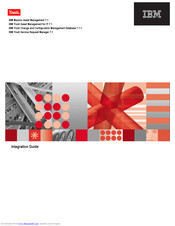IBM Tivoli Service Request Manager 7.1 Manuals
Manuals and User Guides for IBM Tivoli Service Request Manager 7.1. We have 1 IBM Tivoli Service Request Manager 7.1 manual available for free PDF download: Integration Manual
IBM Tivoli Service Request Manager 7.1 Integration Manual (330 pages)
Integration Guide
Table of Contents
-
-
Content27
-
-
-
-
-
-
Root Element77
-
Key Fields81
-
-
Date Format90
-
Null Columns90
-
Key Fields91
-
Viewing XML91
-
-
Schema Name96
-
Schema Name98
-
Schema Name100
-
-
-
IFACENAME Column114
-
TRANSID Column114
-
TRANSSEQ Column116
-
-
ACTION Column117
-
MESSAGEID Column118
-
-
-
Message Details124
-
Message Events127
-
-
-
Message Statuses135
-
Error Correction136
-
Error Details136
-
Process Message137
-
Save Message137
-
Cancel Message137
-
-
Message Deletion138
-
Critical Errors138
-
-
-
Error Research139
-
-
-
-
JMS Queues146
-
Queue Properties147
-
-
Handlers159
-
-
FLATFILE Handler161
-
HTTP Handler162
-
JMS Handler165
-
XMLFILE Handler168
-
CMDLINE Handler169
-
-
-
Cron Tasks174
-
Selectors174
-
Queue Tables175
-
-
-
Continuous Queue179
-
Message Caching182
-
-
Message Header185
-
Message Body186
-
Queue Selectors186
-
Queue Utilities187
-
-
IBM Websphere MQ188
-
-
-
JMS Queues203
-
Global Directory209
-
-
Enterprise Beans210
-
HTTP Servlet210
-
-
-
-
Control Levels223
-
Control Types224
-
Boolean Controls224
-
List Controls224
-
Value Controls224
-
-
-
Publish Channel228
-
Processing Rules229
-
-
-
Services247
-
Web Services248
-
Publish Channels249
-
-
Query Services254
-
-
Field Evaluation259
-
Field Selection260
-
Range Selection261
-
-
-
-
-
-
Notices
321-
Index325
-
Advertisement
Advertisement
